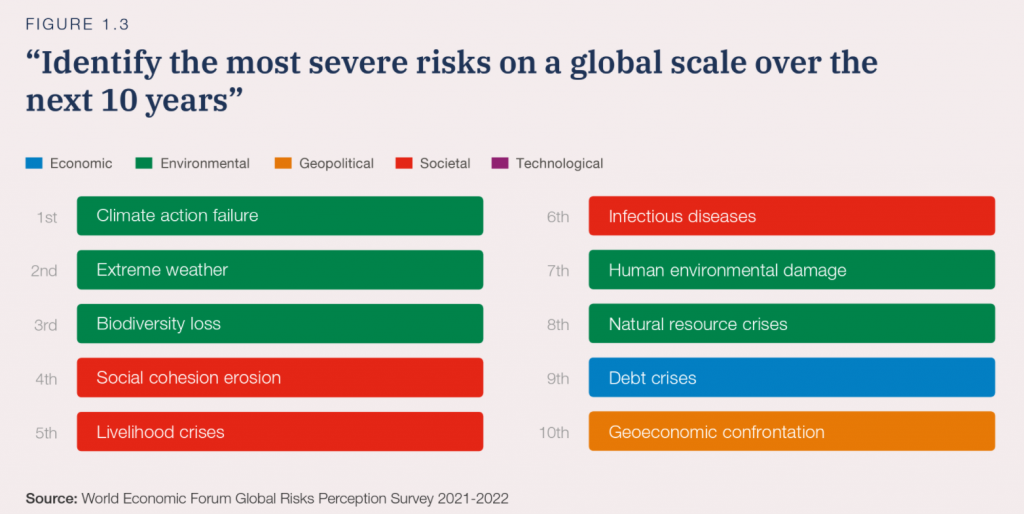After three years of Covid, people around the world are undoubtedly tired of sliding from one crisis to the next. Especially compared to the ongoing pandemic and the Ukrainian war, other global crises seem to lose importance. Experts emphasize the danger of ignoring surfacing warning signs.
Besides the ongoing pandemic, supply chain disruptions, inflation, debt, labor market gaps, and education disparities are just some of the global problems which are currently fostering an unstable global economy. Both fast- and slow-recovering countries must find ways to restore trust and solidarity, as well as to counteract barriers to cooperation.
With the Global Risks Report series, the World Economic Forum (WEF) gives annual insights into global risks across five categories: Economy, environment, society, technology, and geopolitics. As a “global risk” the WEF defines “an uncertain event or condition that, if it occurs, can cause a significant negative impact for several countries or industries within the next 10 years.”
Deep-dives from Global Risks Report 2022
Every year, together with risk experts and world leaders, the WEF examines key risks across these five categories which are provided in deep-dive chapters. These deep-dive chapters contain surfacing warning signs, potential blind spots in risk perceptions, or risks that stand out on the Global Risks Perception Survey (GRPS). The GRPS summarizes the expertise of the Forum’s stakeholder network from business, governments, society, and thought leaders.
In 2022, the reports’ deep dive chapters are comprising a deeper look at the following topics: The growing focus on climate action, a more complex cyber threat landscape, barriers to migration, and lastly, the impact of accelerated space activity that may reshape our world in 2022 and over the next decade. Besides the discussion of potential blind spots and surfacing warning signs, the 2022 report pays special attention to the ongoing pandemic situation and its global consequences.
Global Risks Perception Survey
As shown in the figure below, environmental risks are perceived as the most critical long-term threats, with five environmental risks ranking among the top ten. Further, “climate action failure”, “extreme weather”, and “biodiversity loss” are even seen as the top three severe risks for people and our planet. With an increase in extreme climate change events over the past years, also the year 2021 marked new extremes in weather history. Not only did the heatwave over western North America overtake all unprecedented records, but 2021 showed us the potential impact of climate change also through four mega-disasters, costing over 20$ billion each. With an apparent increase in droughts, fires, floods, resource scarcity, and species loss, people around the world are confronted with the worst possible consequences.
Instead of collaborating on a large scale across industries and borders, climate transition is rather characterized by an increase in barriers to cooperation. These divergent trajectories including technological, societal as well as economic change, will drive countries and societies even further apart, moving the net-zero goal far behind 2050. Given these developments, it is no surprise that GRPS respondents see “climate action failure” as the number one global long-term risk. With debt burdens proliferating throughout the past years, public budgets will be further burdened, with upcoming challenges to shift towards a green economy.
Besides “debt crises” and “geoeconomic confrontations” -which are more relevant these days than ever- respondents also saw three societal risks among the most severe over the next 10 years. After two years of COVID-19, these pandemic experiences reflect in the last GRPS with “Social cohesion erosion”, “livelihood crises” and “infectious diseases” ranking fourth to sixth. These societal threats are demanding lots of short-term political attention on a national scale, hindering global challenges and international cooperation to become the top priority. Consequently, governments will face even bigger obstacles to allocating time and capital towards long-term risks and global threats.

The need for a global response
Each risk on its own has already the potential to create great burdens for governments and society. However, no country on its own will be able to withstand such a combination of economic, ecological, and societal threats, requiring a combined and coordinated global response.
Increasing climate action, ensuring digital safety and societal cohesion while also controlling competition in space are only some of the upcoming global challenges. These challenges cannot be solved without cooperation within and between countries. However, with more tension arising, we see an opposite and disenchanting development, which clearly reduces the hope of many.
As horrifying and cruel the invasion of Russia in Ukraine is, it has also shown that international cooperation on a large scale is possible, giving people the slightest bit of hope that a coordinated and global response towards other threats will follow.
How DFGE can help
This variety of surfacing topics and risks can be overwhelming for any company. Navigating through these topics and finding a path forwards, needs a clear vision and strategic alignment. By conducting a materiality analysis, we can help you to find some structure in the ESG jungle. Contact us via mail or phone 08192-99733-20.









